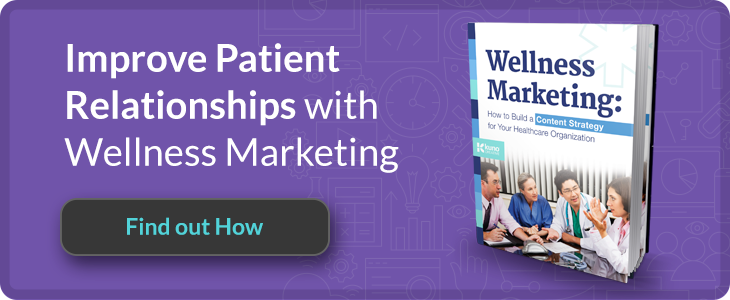
6 Keys to a Strong Healthcare Digital Marketing Strategy

Are you looking for an effective healthcare digital marketing strategy? Well the healthcare industry is continually pursuing the next technological advancement. Whether it’s a new, improved treatment, a groundbreaking facility or the expansion of physician specialties, healthcare organizations are always working to provide a higher level of care for patients.
Unlike any other industry, healthcare serves a broad audience. And today's consumers are becoming more dependent on apps and websites. In fact, patients are relying on websites at an increasing rate to make healthcare decisions.This is why it’s important to stay on top of digital marketing and keep your organization at the forefront of change—even online. Use these six keys to a strong healthcare digital marketing strategy that will reach patients and generate leads in today’s patient-centered market.
Healthcare Digital Marketing Strategy Includes
- Easy-to-Navigate Website
- Informational Blog
- Resourceful Emails
- Videos That Educate and Inspire
- Strong SEO Attributes
- Engaging Social Media Strategy
6 Keys to an Effective Healthcare Digital Marketing Strategy
An Easy-to-Navigate Website
Your website serves as the welcome mat to your organization. It typically is the first impression your company will make and plays a strong role in a patient’s decision to choose your facility or go elsewhere, so you want the user experience to be as easy as possible. Chances are if someone is on your website, they are looking for answers for themselves or a loved one and want to find what they’re looking for quickly so they can take action.
Patients already are looking online for health information, so make sure your website is patient-focused and easy to use. Take the Mayo Clinic’s website, for example. It is user-friendly and has a robust offering right on the homepage.
It’s simple for visitors to make an appointment, contact Mayo Clinic, view resources or log into the patient account. Putting these elements on the homepage makes its easy to find so they don’t have to go searching around the site.
An Informational Healthcare Blog
Your blog goes hand-in-hand with a strong healthcare digital marketing strategy and user-friendly website. With 1 percent of all Google searches related to medical symptoms, and 3.5 billion Google searches, that’s 35 million online medical searches every day. Take advantage of all those searches with rich blog content that provides information on health conditions, answers to questions, quick tips and advice they can get without going to the doctor. Be sure to plan your editorial calendar around health months or other timely topics relevant to your organization.
And don’t forget, people take comfort in reading about other patients who have experienced a treatment, condition or surgery they are facing, so this can help boost your blog’s readership numbers. While you can feature testimonials in various places around your website, your blog is a great place for reading in-depth about another patient's success. Rather than short clips, blogs are trending toward featuring in-depth patient stories on their journey from diagnosis to recovery.
The Harvard Medical School blog has a steady stream of content that covers a variety of health concerns. Its navigation makes it simple to browse topics by health categories, such as men’s health or heart health. Readers can easily find the blog subscription, and engagement is highlighted by showing the most-commented blog posts.
Resourceful Emails
It’s true that patients go searching for information, but email is a way to be a step ahead. What if the information was in their inbox before they had to even look for it? By sending out an email newsletter at least once a month, you’ll continue to educate patients by providing them with fresh content they can apply to their own health.
The key is to provide your email database with a variety of information to best capture your audience’s interest. Use email personalization and segmentation based on a recipient’s interests and needs so they’re receiving information relevant to them. Send out a video, a current blog post or provide industry news that will give readers information on various topics. Be sure to plan these ahead of time so they are timely according to what’s going on at your organization or in the health industry.

This newsletter email sent out by Akron Children’s Hospital in August helps parents of young children with issues facing preschoolers going back to school. Parents who have subscribed are dealing with many of these situations just before school starts, and this email was timely in providing answers to their problems.
Healthcare Videos That Educate and Inspire
Audiences increasingly are leaning more toward visual content. According to Wordstream, one-third of online activity is spent watching video. If you can get your physicians on camera speaking about their area of expertise, it inevitably will add to their credibility and capture an audience that is out there looking for the expertise your physicians have.
This Cleveland Clinic video series shows doctors speaking passionately about their areas of expertise, and describing their views on caring for patients. Watching a doctor in a video describing a condition or procedure can make a patient feel more at ease about what they’re experiencing, especially if they’re seeing that physician for treatment. Video can make a patient feel as though they’ve already met the physician and increase their comfort level by seeing their facial expressions, mannerisms and even hearing their voice.
Like the blog, another appropriate place for testimonials is in your video resources. The only thing better than reading about another patient’s experience is getting to see it in action through video, and hear the doctor, patient and family members describing the experience from beginning to end. Video is a powerful tool; the lighting, music and story structure work together to draw out emotion when telling the story in ways a blog post can’t. These elements can evoke feelings of passion, hope, courage, fear and many others that the written word alone can’t capture.
Strong SEO Attributes
You can have the best-looking, most informative website, blog posts, emails and videos, but what good are they if they’re not being found? Through the process of search engine optimization (SEO), you can increase the quality and quantity of organic traffic by centering your content on specific keywords your patients actually would use in their searches. If you’re a hospital with several service lines, you’ll want to do some keyword research with a tool like SEMrush or the HubSpot keyword tool to determine the best-ranking keywords to use on each page. You’ll want to look for what keywords are currently driving traffic to your website, as well as your competitors'.
When searching in SEMrush for healthcare, you’ll see the top keywords, their search volume, keyword difficulty score and cost per click (CPC):
Using these results, choose a keyword that has a lower difficulty score (so it’s not as difficult to rank for) with a high search volume. Develop your content based on this keyword, and work it into your copy. To optimize a page around a particular service line, you need to include it in the page title, H1, meta description, URL, alt image tags and within the body copy of the page. You can create content around that same keyword and related subtopics and link back to that page. Say your keyword is “Cleveland urologist,” some subtopics might be when to see a urologist, incontinence symptoms or overactive bladder treatment.
Keywords are important, but they must sound natural within the rest of the copy. Avoid overuse of the keyword phrase on the page; Google will penalize you for “keyword stuffing” if your phrase appears too many times. While you want the words within the copy, quality content is still king.
Engaging Healthcare Social Media Strategy
If your healthcare organization isn’t on social media, you’re missing a huge opportunity to connect with your audience. Social media is an excellent promotional tool when used right.
In fact, 60 percent of social media users are most likely to trust social media posts and activity by doctors over any other group, according to Infographics Archive. So plan your posts wisely—make sure they are written ahead of time and offer a variety of content on your page. A social media presence expands your reach to patients.
Cedars-Sinai Medical Center has all the elements needed for a successful social media strategy.
The hospital shares videos, blog posts highlighting its staff caring for patients, upcoming events and dozens of positive patient reviews. A great feature is a “Book Now” button that takes patients to the hospital’s physician page, so patients can easily locate a doctor for their needs.
Tying It All Together
A strong healthcare digital marketing strategy is most effective when it is managed in a streamlined way, where each component is in sync with one another, rather than siloed. In addition to regularly meeting with your team about your marketing strategy to discuss changes or updates, connect these elements through a content management platform. This enables you to track the performance of your efforts as a whole and identify areas for improvement. In fact, many healthcare organizations already are managing their digital marketing efforts on HubSpot or other similar platforms. Doing so helps them review previous efforts, and makes planning their future strategies easier. Platforms like HubSpot can support your marketing endeavors through their continual updates to help you better serve the healthcare industry and the users you are working to attract.
Are you looking to create compelling content for your patients and expand your healthcare organization’s reach? Learn more by downloading our eBook, Wellness Marketing: How to Build a Content Strategy for Your Healthcare Organization.
If you would like to see some of Kuno Creative's success with digital healthcare marketing, click here.





